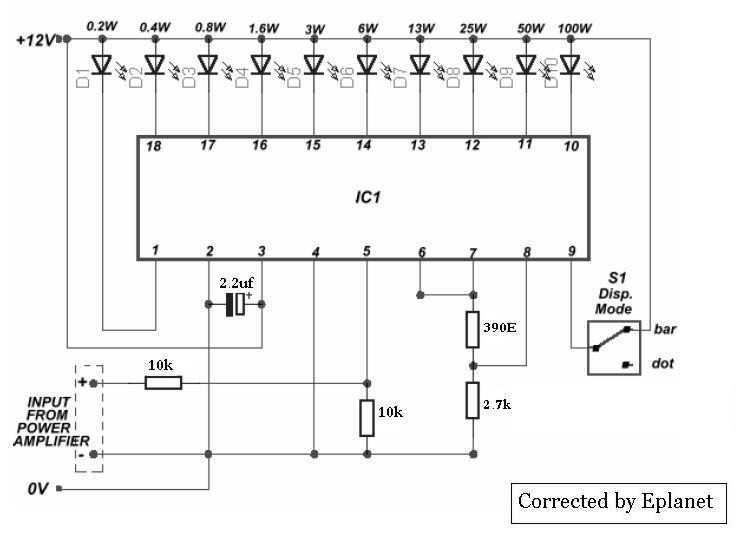
Stereo balance meter

To utilize the indicator, set the amplifier to mono mode and modify the balance control until both LEDs are equally lit. The amplifier is now in optimal stereo mode balance.
The circuit described involves an amplifier with a built-in indicator system that utilizes LEDs to provide visual feedback on the balance of audio output. When the amplifier is switched to mono mode, it combines the left and right audio channels into a single channel. This mode is essential for adjusting the balance control, which is a variable resistor that alters the relative volume levels of the left and right channels.
In this configuration, the balance control is adjusted to achieve equal illumination of both LEDs, indicating that the audio output is balanced. The LEDs serve as visual indicators, where each LED corresponds to one of the audio channels. When both LEDs shine with equal brightness, the output is perfectly balanced, ensuring that the sound is evenly distributed to the speakers.
The amplifier's circuitry likely includes a microcontroller or a simple comparator circuit that monitors the output levels of each channel. This system can be designed to provide feedback in real-time, allowing for precise adjustments. The use of mono mode simplifies the balance adjustment process by eliminating the complexities of stereo sound, making it easier for users to achieve the desired auditory experience.
Once the balance control is set correctly, the amplifier can be switched back to stereo mode, allowing for a full stereo sound experience with the channels properly balanced. This feature is particularly useful in audio setups where channel imbalances can significantly affect sound quality and listener experience.To use the indicator, switch the amplifier to mono mode and adjust the balance control until both LEDs are equally illuminated. The amplifier is now in perfect stereo mode balance. 🔗 External reference
The circuit described involves an amplifier with a built-in indicator system that utilizes LEDs to provide visual feedback on the balance of audio output. When the amplifier is switched to mono mode, it combines the left and right audio channels into a single channel. This mode is essential for adjusting the balance control, which is a variable resistor that alters the relative volume levels of the left and right channels.
In this configuration, the balance control is adjusted to achieve equal illumination of both LEDs, indicating that the audio output is balanced. The LEDs serve as visual indicators, where each LED corresponds to one of the audio channels. When both LEDs shine with equal brightness, the output is perfectly balanced, ensuring that the sound is evenly distributed to the speakers.
The amplifier's circuitry likely includes a microcontroller or a simple comparator circuit that monitors the output levels of each channel. This system can be designed to provide feedback in real-time, allowing for precise adjustments. The use of mono mode simplifies the balance adjustment process by eliminating the complexities of stereo sound, making it easier for users to achieve the desired auditory experience.
Once the balance control is set correctly, the amplifier can be switched back to stereo mode, allowing for a full stereo sound experience with the channels properly balanced. This feature is particularly useful in audio setups where channel imbalances can significantly affect sound quality and listener experience.To use the indicator, switch the amplifier to mono mode and adjust the balance control until both LEDs are equally illuminated. The amplifier is now in perfect stereo mode balance. 🔗 External reference





